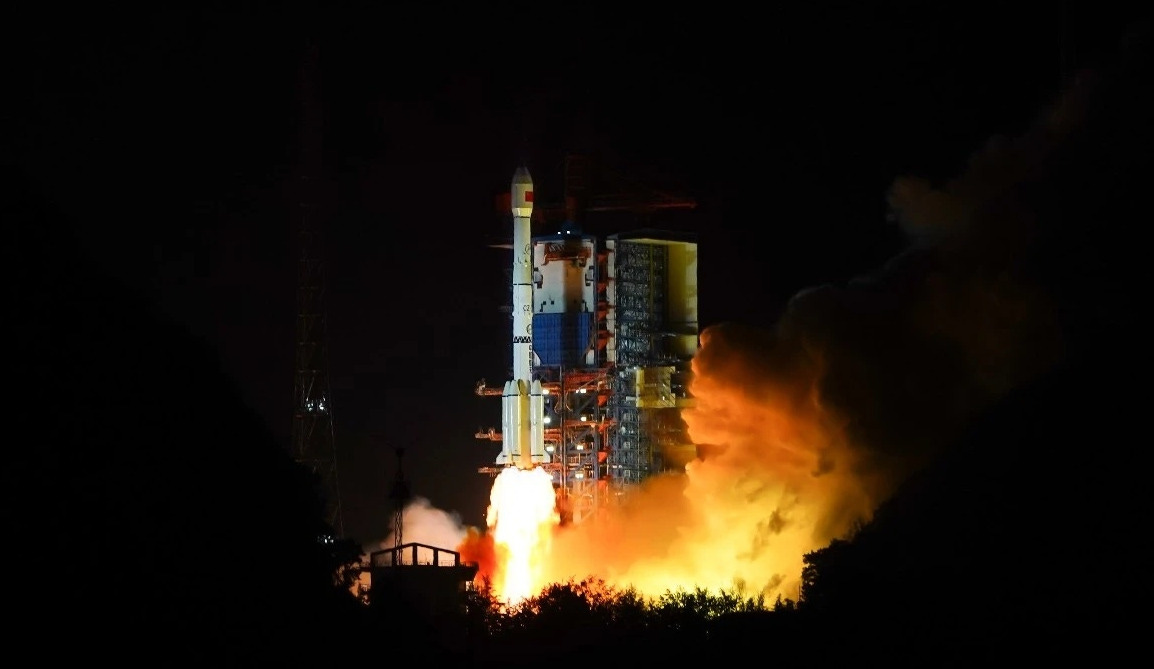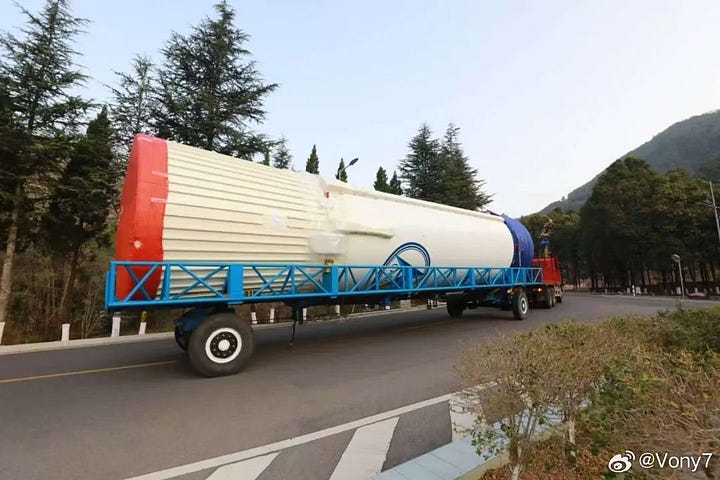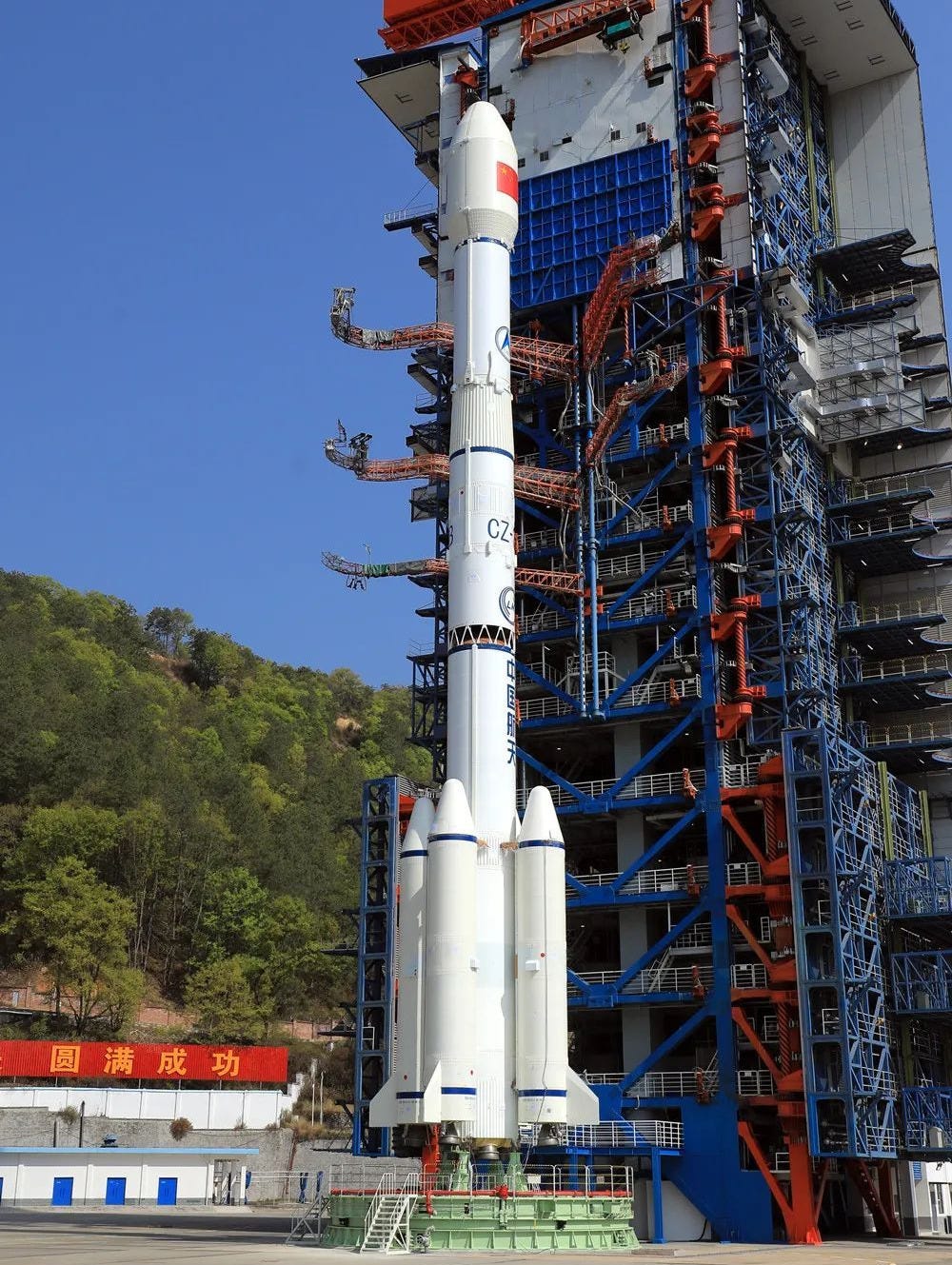China's Geostationary Workhorse on Track for Record Year [Long March 3B/E]
This year's fourth TJSW satellite has been delivered into orbit.

At 00:47 am China Standard Time on April 11th (16:47 Universal Coordinated Time on April 10th) a Long March 3B/E lifted off from Launch Complex 3 at the Xichang Satellite Launch Center. Today’s mission once again had the rocket heading to a geostationary transfer orbit carrying a single spacecraft.
Atop of the Long March 3B/E was the TJSW-17 satellite (通信技术试验卫星十七号), called Communication Technology Experimental Satellite-17 in English. Like prior TJSW satellites launched this year, uses for the satellite are set to be communications, radio, television, and data transmission, as well as testing and verification for multi-band high-speed throughput communications technologies.
TJSW-17 was developed by the Shanghai Academy of Spaceflight Technology. The Shanghai Academy has developed three other TJSW satellites launched this year, between January and March.
With the launch earlier today, six Long March 3B/E’s have flown this year, all successfully. Toward the end of last year, the China Academy of Launch Vehicle Technology boasted that they were aiming to launch the Long March 3B/E over a dozen times per year. With the present launch rate, around twenty launch missions utilizing the rocket could occur before the end of 2025, by far the vehicle’s busiest year.
Following today’s launch mission, the China Academy of Launch Vehicle Technology’s celebratory blog post stated that teams have been actively working on launch vehicles in parallel, moving personnel where needed, strengthening pre-launch preparations in order to support a growing launch cadence of the geostationary launch workhorse. Additionally, after March 9th’s launch the Launch Vehicle Academy shared:
“As the single launch vehicle with the most launches in China's aerospace industry, the Long March 3B rocket has gone through a large number of launch missions, and its technical maturity and reliability are obvious to all. However, the model team has always insisted on technological innovation and reliability improvement, and continuously improved the overall performance and competitiveness of the rocket. Some of the onboard products of the present launch vehicle have been unified with those of the Long March 7A launch vehicle, and have been optimized with the innovative technologies applied by the new generation of launch vehicles. Meanwhile, the level of generalization of the onboard products has been further strengthened to improve the efficiency and reliability of the rocket production, and to push forward the reduction of cost and increase of efficiency.”
If there are any problems with this translation please reach out and correct me.
Today’s mission was the 107th launch of a Long March 3B vehicle, and the 569th launch of the Long March launch vehicle series. This was also the 20th launch from China in 2025.
Liftoff footage via 我们的太空 and 空天逐梦 on Weibo. Local livestream of launch via ThatSpaceDogeGuy on YouTube.
Post-release update
Two days after launch, one of the fairing halves was found on a rural roadway. Both fairing halves are very light for their size and can travel quite far. Additionally, enterprising individuals take them if possible to go and build canopies or gazebos in rural areas, as the fairing halves are inert by the time they reach the ground.
This is the second time a Long March vehicle has had hardware found by the public this year.


Check out the previous Long March 3B/E launch
Crewed Spacecraft Communications Satellite Launched! [Long March 3B/E]
On March 26th at 23:55 pm China Standard Time (15:55 pm Universal Coordinated Time), a Long March 3B/E lifted off from Launch Complex 2 at the Xichang Satellite Launch Center heading for geostationary transfer orbit. Like the rocket’s previous mission
What is the Long March 3B/E?
This section is for those less familiar with China's Long March series of launch vehicles.
The Long March 3B is an older-generation geostationary orbit workhorse of the China Academy of Launch Vehicle Technology. The first two stages and four boosters of the rocket burn Dinitrogen Tetroxide and Unsymmetrical Dimethylhydrazine, with liquid hydrogen and liquid oxygen in the third-stage.
Over the rocket's almost twenty-eight-year launch history, two versions of the vehicle have flown, the 3B and 3B/E. Since 2012 only the 3B/E variant has flown due to its increased payload capacity. The payload capacity of the launch vehicle is currently as follows:
11,500 kilograms to low Earth orbit
7,100 kilograms to a sun-synchronous orbit
5,500 kilograms into a geostationary transfer orbit
2,000 kilograms into geostationary orbit
The first-stage is powered by four YF-21C engines that burn Dinitrogen Tetroxide and Unsymmetrical Dimethylhydrazine to generate 302 tons of thrust, while the boosters are powered by one YF-25 engine burning the same fuel to generate 72 tons of thrust each. Combined the four boosters and first stage generate a thrust of 590 tons. The second stage is powered by one YF-22E and four YF-23F vernier engines that also burn Dinitrogen Tetroxide and Unsymmetrical Dimethylhydrazine to generate 81 tons of thrust. The third-stage is powered by two YF-75 engines that burn liquid hydrogen and liquid oxygen to generate 17 tons of thrust.
On the launch pad, the Long March 3B/E is 56.3 meters tall and weighs 458,970 kilograms when fully fuelled. The first and second-stage have a diameter of 3.35 meters, while the third-stage has a diameter of 3 meters, along with the four boosters diameter of 2.25 meters, and the fairing has a diameter of 4.2 meters.
So far every Long March 3B launch has occurred from the Xichang Satellite Launch Center, in the south of Sichuan province.






![Crewed Spacecraft Communications Satellite Launched! [Long March 3B/E]](https://substackcdn.com/image/fetch/$s_!pTgk!,w_1300,h_650,c_fill,f_auto,q_auto:good,fl_progressive:steep,g_auto/https%3A%2F%2Fsubstack-post-media.s3.amazonaws.com%2Fpublic%2Fimages%2F94dda62e-5206-4e4e-88f6-5204f05e4233_3277x2172.jpeg)
